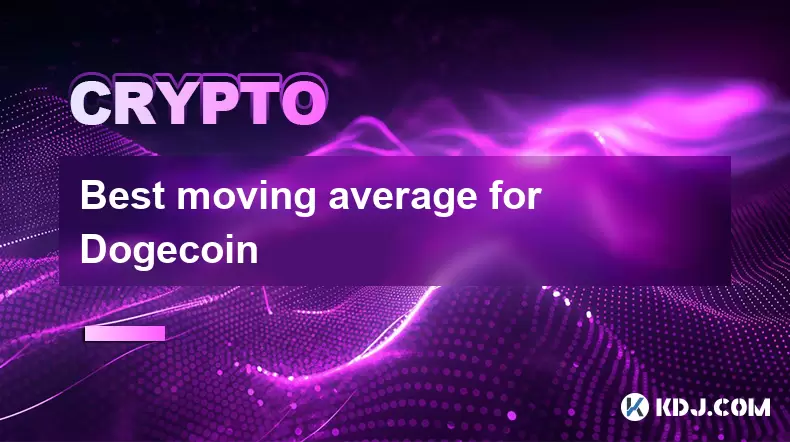-
 bitcoin
bitcoin $107015.826941 USD
-2.18% -
 ethereum
ethereum $3637.352324 USD
-5.18% -
 tether
tether $0.999831 USD
-0.02% -
 xrp
xrp $2.338078 USD
-6.23% -
 bnb
bnb $998.272150 USD
-6.97% -
 solana
solana $167.598257 USD
-10.12% -
 usd-coin
usd-coin $0.999863 USD
0.01% -
 tron
tron $0.282573 USD
-5.09% -
 dogecoin
dogecoin $0.169891 USD
-7.39% -
 cardano
cardano $0.557554 USD
-7.03% -
 hyperliquid
hyperliquid $39.914802 USD
-5.85% -
 chainlink
chainlink $15.414549 USD
-9.97% -
 bitcoin-cash
bitcoin-cash $510.361911 USD
-4.26% -
 ethena-usde
ethena-usde $0.999194 USD
-0.03% -
 stellar
stellar $0.282092 USD
-6.07%
Best moving average for Bitcoincoin
For Dogecoin trading, combining EMAs with RSI and volume analysis helps filter false signals and improve decision-making.
Jul 05, 2025 at 07:31 pm

Understanding Moving Averages in Cryptocurrency Trading
Moving averages are among the most widely used technical indicators in cryptocurrency trading. They help smooth out price data over a specific time period, offering traders a clearer view of trends. For Dogecoin (DOGE), which is known for its volatile and often unpredictable price movements, selecting the right moving average can significantly enhance decision-making. Unlike traditional assets, cryptocurrencies like Dogecoin experience rapid shifts due to social media influence, market sentiment, and macroeconomic factors. Therefore, understanding how different moving averages perform under such conditions becomes crucial.
A moving average essentially calculates the average price of an asset over a defined number of periods. The two primary types are the Simple Moving Average (SMA) and the Exponential Moving Average (EMA). SMA gives equal weight to all prices within the selected timeframe, while EMA assigns more weight to recent prices, making it more responsive to new information. Since Dogecoin often reacts swiftly to news and online trends, EMA might be more effective in capturing these sudden changes compared to SMA.
Choosing Between Short-Term and Long-Term Moving Averages
The effectiveness of a moving average depends heavily on the trader's strategy and investment horizon. Short-term moving averages, such as the 9-day or 20-day, react quickly to price changes and are commonly used by day traders and swing traders. On the other hand, long-term moving averages like the 50-day or 200-day provide broader trend signals and are preferred by investors with a longer holding period.
For Dogecoin, short-term EMAs like the 9-day EMA have proven useful for identifying quick entry and exit points. These fast-moving averages help traders catch momentum spikes driven by social media events, especially those originating from platforms like Twitter and Reddit. In contrast, the 50-day EMA offers a balanced view between responsiveness and reliability, filtering out some of the noise associated with shorter intervals. Meanwhile, the 200-day SMA acts as a key psychological level, often indicating whether Dogecoin is in a bull or bear phase.
Using Moving Average Crossovers for Trade Signals
One of the most popular strategies involving moving averages is the crossover method. This technique involves using two moving averages — one short-term and one long-term — to generate buy or sell signals based on their relationship.
- When the short-term moving average crosses above the long-term moving average, it generates a bullish signal.
- Conversely, when the short-term MA crosses below the long-term MA, it indicates a bearish trend.
In the context of Dogecoin, the 'Golden Cross' (when the 50-day EMA crosses above the 200-day SMA) has historically signaled strong upward momentum. Similarly, the 'Death Cross' (when the 50-day EMA drops below the 200-day SMA) has preceded significant downturns. Traders who monitor these crossovers closely may find them particularly valuable when combined with volume analysis and sentiment tracking tools.
Combining Moving Averages with Other Indicators
Relying solely on moving averages can lead to false signals, especially in highly volatile markets like that of Dogecoin. To mitigate this risk, traders often combine moving averages with other technical indicators to confirm trends and filter out misleading signals.
- The Relative Strength Index (RSI) helps determine overbought or oversold conditions.
- Volume indicators like On-Balance Volume (OBV) add confirmation to price movements.
- Bollinger Bands can provide volatility insights alongside moving average trends.
For instance, if Dogecoin’s price is rising above the 20-day EMA but the RSI is already in overbought territory (>70), it could suggest a potential pullback. Similarly, if the 50-day EMA is trending upward but OBV is declining, it might indicate weakening buying pressure despite the positive moving average alignment.
Customizing Moving Averages for Dogecoin’s Unique Behavior
Dogecoin's price behavior differs from more traditional cryptocurrencies like Bitcoin or Ethereum due to its meme-based origins and susceptibility to hype cycles. As such, standard moving average settings may not always apply effectively.
- Traders should consider adjusting the period lengths based on historical volatility patterns of DOGE.
- Testing various combinations on past data (backtesting) can reveal optimal setups.
Some traders use adaptive moving averages that automatically adjust sensitivity based on market volatility. Tools like the Variable Index Dynamic Average (VIDYA) or the Kaufman Adaptive Moving Average (KAMA) can offer better performance in erratic markets like Dogecoin. By incorporating these advanced techniques, traders can fine-tune their strategies to align more closely with DOGE's unique characteristics.
Frequently Asked Questions
Q: Can I rely solely on moving averages for trading Dogecoin?While moving averages are powerful tools, they work best when combined with other indicators like RSI, MACD, or volume analysis. Dogecoin's price is heavily influenced by external factors, so relying solely on moving averages may result in missed opportunities or false signals.
Q: What time frame is best for applying moving averages to Dogecoin?The ideal time frame depends on your trading style. Day traders often use 1-hour or 4-hour charts with short-term EMAs like the 9-day or 20-day. Long-term investors prefer daily or weekly charts with the 50-day and 200-day moving averages to gauge overall trend direction.
Q: How do I set up moving averages on my trading platform for Dogecoin?Most platforms like Binance, TradingView, or Coinbase allow you to add moving averages directly from the indicator menu. Select either SMA or EMA, input the desired period (e.g., 9, 20, 50), and apply it to the Dogecoin chart. You can overlay multiple averages for crossover strategies.
Q: Do moving averages work equally well for all cryptocurrencies?No, because each cryptocurrency exhibits different volatility and market behavior. While moving averages are generally effective, coins like Dogecoin, which are prone to sudden hype-driven rallies, may require more dynamic or adaptive versions of moving averages for accurate readings.
Disclaimer:info@kdj.com
The information provided is not trading advice. kdj.com does not assume any responsibility for any investments made based on the information provided in this article. Cryptocurrencies are highly volatile and it is highly recommended that you invest with caution after thorough research!
If you believe that the content used on this website infringes your copyright, please contact us immediately (info@kdj.com) and we will delete it promptly.
- Milk Mocha's $HUGS: The Presale Meme Coin Redefining Community and Value
- 2025-11-04 17:50:02
- Dogecoin, Lyno AI, and Growth Potential: A New Era for Crypto?
- 2025-11-04 17:45:01
- DASH Price Surges Amid Aster Listing: Market Confidence Returns?
- 2025-11-04 17:45:14
- Crypto Price Predictions: DeFi Coins to Watch in 2026 – Will MUTM Outshine XRP?
- 2025-11-04 17:50:01
- Rare Coin Mania: The Red Coin Collectors Rush!
- 2025-11-04 17:55:02
- Shiba Inu, Blue Kachina, and a Message: What's the Buzz?
- 2025-11-04 17:55:02
Related knowledge

Bitcoincoin burning mechanism
Jul 20,2025 at 09:21pm
What is the Dogecoin burning mechanism?The Dogecoin burning mechanism refers to the process of permanently removing DOGE tokens from circulation by se...

How to earn free Bitcoincoin?
Jul 19,2025 at 10:08pm
What is Dogecoin and Why Earn It?Dogecoin (DOGE) started as a meme-based cryptocurrency in 2013 but has grown into a widely recognized digital asset. ...

Is Coinbase a good wallet for Bitcoincoin?
Jul 19,2025 at 04:42pm
Understanding Coinbase as a Wallet Option for DogecoinWhen considering where to store Dogecoin, Coinbase is often mentioned as a potential option due ...

How to buy Bitcoincoin with PayPal?
Jul 23,2025 at 06:57am
Understanding the Basics of Buying DogecoinBefore diving into the process of buying Dogecoin with PayPal, it’s essential to understand what Dogecoin i...

Best app to buy Dogecoin
Jul 23,2025 at 03:08pm
What Is a Cryptocurrency Exchange and How Does It Work?A cryptocurrency exchange is a digital marketplace where users can buy, sell, or trade cryptocu...

How are Dogecoin gains taxed?
Jul 25,2025 at 07:01am
Understanding the Taxation of Dogecoin GainsWhen it comes to Dogecoin (DOGE), many investors are drawn to its meme-inspired branding and volatile pric...

Bitcoincoin burning mechanism
Jul 20,2025 at 09:21pm
What is the Dogecoin burning mechanism?The Dogecoin burning mechanism refers to the process of permanently removing DOGE tokens from circulation by se...

How to earn free Bitcoincoin?
Jul 19,2025 at 10:08pm
What is Dogecoin and Why Earn It?Dogecoin (DOGE) started as a meme-based cryptocurrency in 2013 but has grown into a widely recognized digital asset. ...

Is Coinbase a good wallet for Bitcoincoin?
Jul 19,2025 at 04:42pm
Understanding Coinbase as a Wallet Option for DogecoinWhen considering where to store Dogecoin, Coinbase is often mentioned as a potential option due ...

How to buy Bitcoincoin with PayPal?
Jul 23,2025 at 06:57am
Understanding the Basics of Buying DogecoinBefore diving into the process of buying Dogecoin with PayPal, it’s essential to understand what Dogecoin i...

Best app to buy Dogecoin
Jul 23,2025 at 03:08pm
What Is a Cryptocurrency Exchange and How Does It Work?A cryptocurrency exchange is a digital marketplace where users can buy, sell, or trade cryptocu...

How are Dogecoin gains taxed?
Jul 25,2025 at 07:01am
Understanding the Taxation of Dogecoin GainsWhen it comes to Dogecoin (DOGE), many investors are drawn to its meme-inspired branding and volatile pric...
See all articles










































































